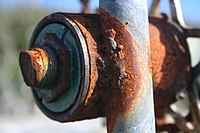
Photo from wikipedia
This work presents the modeling and simulation of CO2 capture by a water-based Titanium dioxide (TiO2) solid nanoparticle in a stirred high-pressure vessel at a constant temperature. Photocatalytic material such… Click to show full abstract
This work presents the modeling and simulation of CO2 capture by a water-based Titanium dioxide (TiO2) solid nanoparticle in a stirred high-pressure vessel at a constant temperature. Photocatalytic material such as TiO2 has excellent properties, namely it is nontoxic, inexpensive, and non-polluting. CFD model equations are developed and solved using COMSOL software package. The effect of the concentration of a solid nanoparticle in a water-based TiO2 solution, the size of TiO2 nanoparticles and the rate of mixing on the CO2 absorption rate is investigated. A 2D mathematical model considers both shuttle and micro-convention mechanisms. Results reveal that the best TiO2 concentration range is between 0.5 and 1 kg/m3 and that a particle size of 10 nm is more efficient than higher particle sizes. A moderate mixing rate maximizes the CO2 removal rate. The theoretical predictions are validated using lab experimental data and those in the available literature. Results confirm that the model calculations match with the experimental results. Accordingly, the model successfully predicts the experimental data and can be used for further studies.
Journal Title: Scientific Reports
Year Published: 2021
Link to full text (if available)
Share on Social Media: Sign Up to like & get
recommendations!